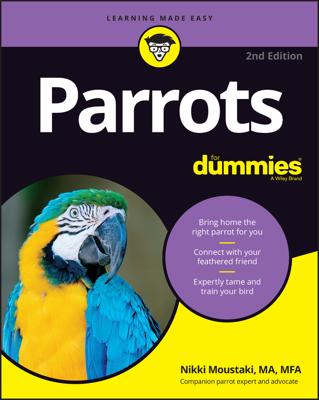Because many parrots are long-lived, you have the opportunity to welcome a baby or a senior into your home. Yes, there's a difference between baby behavior and adult behavior, but even if you get a baby parrot you'll experience its adult behavior sooner or later.
It's a myth that baby parrots bond more deeply to human families than adult parrots when placed in a new home. Parrots are very adaptable animals and appreciate people who are respectful of them — beside above-adequate housing, nutrition, proper lighting, and veterinary care, that's about all they ask of us.
An adult parrot in a new home can become very bonded to its new family. On the other hand, an adult bird with social problems may never become affectionate and may never even like its new guardians, but that has less to do with age than it does with how the parrot was raised and treated by its previous humans.
Baby parrots
Baby parrots are sweet and practically beg you to take them home. Unfortunately, baby behavior is not really an indication of adult behavior. Remember that the sweet baby is going to grow up, become an adult, and display all the adult behavior typical to its species.
Baby parrots go through five basic baby stages:
- Neonate: A neonate is any baby parrot that is not yet eating on its own and relies on its parents or a human to feed it. Typically, this term refers to very young babies with their eyes still closed, also called hatchlings. All neonates can also be called chicks.
- Nestling: When the baby gets a little older and its eyes are open, you can call it a nestling. It still relies on a parent or human for food.
- Fledgling: When a parrot begins to fly, it is considered to be fledging the nest and is called a fledgling. It may be eating some food on its own, but it still relies on the parents (or a human) for food.
- Weanling: A weanling is a baby parrot that is in the process of weaning (just starting to eat on its own).
- Juvenile: A juvenile is a baby that is weaned (independent of its parents and eating on its own) but isn't yet sexually mature.
The time from hatching to juvenile is different for every species. Budgies can be weaned in about six weeks. Hyacinth macaws can take nine months to wean.
Juvenile parrots are the same size as adult parrots. The only real way to tell age is by looking at the bird's closed leg band. If the bird doesn't have a band, you can often tell a juvenile parrot by the color of its eyes, which will often be darker or a different color. Plumage in some juvenile species is also different. For example, sun conure juveniles are greener than they are orange and yellow. These birds feather out into their mature colors after a year or two.
Never buy a parrot that is still dependent on handfeeding formula, especially if you're not experienced in handfeeding. Many highly experienced parrot breeders have accidentally asphyxiated (choked) a baby bird to death. Handfeeding isn't an exact science and takes a lot of practice and patience. You can buy a baby when it's nearly weaned and still eating soft, warm, nearly solid food but not when it still has to be handfed with a syringe.
Mature parrots
A mature parrot is one that can breed and produce young. It has passed the juvenile stage, and its personality is already formed. Don't rule out a mature parrot as a companion. If a lovebird is three years old, it's in the first fifth of its lifespan. If a blue and gold macaw is 10 years old, it is in the prime of its life, with 70 more years to go if cared for properly.
In the wild, baby parrots wean and then leave their parents to find mates. In captivity, many handfed parrots "turn" on their handfeeders, preferring instead someone else in the household. It makes sense to the bird to leave its genetic family, so a mature bird may actually appreciate bonding to someone beside the human parent who raised it.
Older parrots
An older parrot is in the last third of its lifespan — for example, a lovebird that's 10 or an African grey that's about 35 years old. Unfortunately, most parrots don't even make it to an age where they can be considered older. It's the lucky parrot whose guardians are conscientious enough to keep it alive and happy into its golden years.
There's no reason why you shouldn't welcome an older bird into your home. Yes, its personality is pretty much formed by the time the bird is well into its adulthood, but if you can accept the bird for who it is as an individual, then you may find a good friend, even if you had nothing to do with its upbringing.

